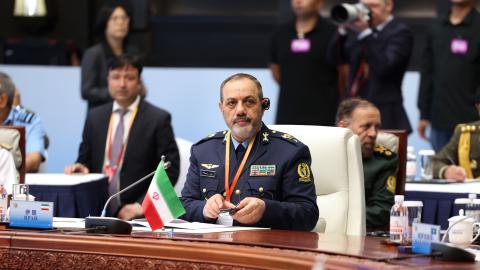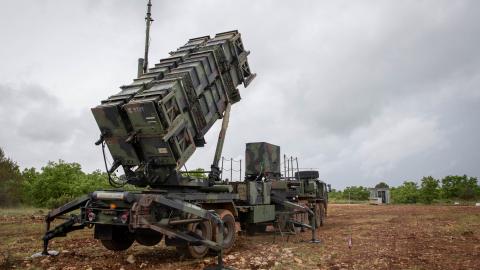The following are indicators of another dimension of Irans hostile actions its links with Al-Qaeda.
December 1995 An Egyptian member of Al-Qaeda Mustafa Hamid (also known as Abu Walid) visited Iran. It is believed that he had meetings with representatives of the Iranian Revolutionary Guard Corps to discuss cooperation.[1]
May 1996 Bin Laden and most of Al-Qaeda expelled from Sudan under mounting US and international pressure.[2]
July 31, 1996 According to intelligence reports obtained by The New York Times, Abdullah Nuri, leader of the Islamic Renaissance Party of Tajikistan, which is part of the United Tajik Opposition, approached agents of the Iranian Ministry of Intelligence and Security in Taliqan Afghanistan. Nuri conveyed a request from bin Laden to the Iranian agents for a meeting in Afghanistan.[3]
August 23, 1996 Bin Laden issues his declaration of war against the United States of America.[4]
Mid 1996-1998 10% of all of Osama bin Laden s outgoing satellite phone calls are to Iran.[5]
February 23, 1998 A fatwa (edict) entitled International Islamic Front for Jihad on the Jews and Crusaders is issued by Bin Laden together with Ayman al-Zawahiri (Jihad Group in Egypt), Abu-Yasir Rifa'i Ahmad Taha (Egyptian Islamic Group), Shaykh Mir Hamzah (Jamiat-ul-Ulema-e-Pakistan) and Fazlur Rahman (Jihad Movement in Bangladesh). This fatwa calls for the targeting of all Americans anywhere in the world.[6]
October 20, 2000 Ali Muhammad in testimony before the Southern District for New York federal court described setting up meetings in the early 1990s between Osama bin Laden and Imad Mughniyeh of Hezbollah[7] (a terrorist group supported/directed by Iran since its formation.)
October 2001 The Iranian governments extensive ties to the Egyptian Islamic Jihad, a partner of bin Ladens Al-Qaeda organization, were presented in a briefing for Deputy Secretary of Defense Paul Wolfowitz. The former leader of the Egyptian Islamic Jihad, Ayman al-Zawahiri is believed to be bin Ladens top deputy and successor and the mastermind behind the Sept. 11 attacks. Zawahiri traveled repeatedly to Iran in the 1990s as a guest of both the Minister of Intelligence and Security and the commander of the Quds force[8] (one offensive covert action unit).
Early October 2001 According to a European intelligence official, fugitive Lebanese terrorist Imad Mugniyeh, who reports directly to Iranian military intelligence, met in Mashad, Iran with a senior Iranian intelligence officer and a top deputy to Saddam Hussein in charge of intelligence matters to discuss cooperation with bin Laden. Mugniyeh also purportedly met in Sudan with Hezbollahs chief and bin Laden in the early 1990s.[9]
January 10, 2002 President Bush states [Iran] must be with us or against us in the war against terrorism and make no attempt to destabilize the interim Afghan government Iran must be a contributor in the war against terror; our nation and our fight against terror will uphold the doctrine, either you're with us or against us; and any nation that thwarts our ability to rout terror out where it exists will be held to account, one way or the other, if they [the Iranians] are trying -- if they in anyway, shape, or form -- try to destabilize the government [of Afghanistan], the coalition ... we'll deal with them, in diplomatic ways, initially [10]
April 2002 Reports of direct Iranian assistance to the Islamic Movement of Uzbekistan. The IMU has close ties to bin Ladens al Qaeda; its fighters fought in Afghanistan against US forces. Military officials from the Iranian Revolutionary Guard Corps have been training and supporting the IMU.[11]
April 2002 U.S. Secretary of Defense Donald Rumsfeld states There is no question but that al Qaeda have moved into Iran and out of Iran to the south and dispersed to some other countries.[12]
June 2002 Iran hosts a two-day conference on the liberation of Palestine. In attendance are leaders from the Palestinian Islamic Jihad movement and from the Popular Front for the Liberation of Palestine-General Command, as well as representatives of Hamas, Hezbollah, and the Palestinian Authority.
According to a report in the London Al-Sharq Al-Awsat, Iranian officials stated their intention of increasing financial aid to some of the organizations in attendance. Supreme Leader Khamenei also promised to increase the budget of the Islamic Jihad by 70% to cover the expense of recruiting young Palestinians for suicide operations. [13]
July 2002 Iran finances training bases in Lebanon to instruct Hezbollah and Palestinian insurgents in the use of SA-7 shoulder launched surface-to-air missiles.[14] (These are the same type of missiles used by members of Al-Qaeda in the November 28, 2002 attempt to down an Israeli airliner in Kenya.)
September 26, 2002 Reports surfaced from a variety of news outlets of an Al-Qaeda training camp within Iran just over the border from Afghanistan.[15]
February 18, 2003 Hamid Reza Zakeri who claims to have worked for Iranian intelligence gave an interview in London to the Arabic language paper Al-Sharq Al-Awsat stating that Iran through Hezbollah has had an ongoing relationship with Al-Qaeda. Zakeri outlined the connection between Imad Mughniyah (Number 2 man in the Hezbollah security apparatus, head of Hezbollah operations, and on the FBIs list of 25 most wanted terrorist) with Ayman al-Zawahiri (second in command of Al-Qaeda). Zakeri said that Mughniyah organized the evacuation of key Al-Qaeda members to Iran.[16]
May 12, 2003 A series of three car bombs in Saudi Arabia kill 34 people including nine Americas, and wound over 200 others including some U.S. citizens. This attack launched by Al-Qaeda elements is believed to have been planned and ordered from within Iran.[17]
May 18, 2003 Saif Adel an Egyptian who is believed to be the military commander for Al-Qaeda is reportedly the person who gave the go ahead for the bombings in Saudi Arabia on May 12. Saif Adel is believed to be hiding in Iran along with Abu Mohammed Masri (head of training for Al-Qaeda) Saad bin Laden, and Abu Musab Zarqawi. Zarqawi who was receiving medical care in Baghdad following the fall of the Taliban, apparently fled to Iran prior to the liberation of Iraq, and he is reportedly the head of Ansar al Islam.[18]
July 2003 Iran has announced that it has captured and is holding a number of Al-Qaeda operatives. Among those believed to be in custody are: Osama bin Ladens son Saad bin Laden, Al Qaeda spokesman Sulaiman Abu Ghaith, and Saif al-Adel, believed to be in charge of military operations including the March bombings in Saudi Arabia. Iran has refused to identify those they are holding and will not turn them over to the US. However, they have held out the possibility of extradition to third countries. [19]
October 14, 2003 A report carried in The Washington Post explains how the Quds Force of the Iranian Revolutionary Guard Corps is providing protection and safe haven to several members of the al-Qaeda leadership. It states that Ayman Zawahiri, negotiated with Ahmad Vahidi (former commander of the Quds Force, and one of the key liaisons in the decade old relationship between Al-Qaeda and Iran) for safe passage from Afghanistan (Tora Bora) in December 2001. They have been under Quds protection in Iran ever since.[20]
January 23, 2004 Federal prosecutors in the ongoing trial in Germany of Abdelghani Mzoudi sought to introduce the testimony of Hamid Reza Zakeri, reportedly a former member of the Iranian Revolutionary Guard Corps. Zakeri offered to testify about how the Iranian Revolutionary Guard Corps had contacts with Osama bin Laden's al Qaeda network relating to the September 11th attack, and how he tried to warn Washington through the U.S. embassy in Azerbaijan about the attacks in mid-2001, but the CIA would not believe him. Zakeri offered to discuss how "In 2001, a delegation with Osama bin Laden's son was in Iran," and how the Iranian secret service had worked with al Qaeda in 1996 in an attack in Saudi Arabia [Khobar Tower].[21]
February 1, 2004 Terrorists/sympathizers from approximately 40 countries around the world start a 10 day conference labeled the Ten-Days of Dawn in Tehran. Militant Sunni organizations, including two linked to Al Qaida, Ansar al-Islam, and Hizb Islami, as well as Latin American terrorist organizations, Irish, Basque and Corsican separatists, and a variety of far left groups from Spartacists to Trotskyites and Guevarists attend. Tehran is the only capital where all the Palestinian terrorist movements have offices and, in some cases, training and financial facilities. At the last such gathering Iran increased its funding to the Islamic Jihad by 70%.[22] (See June 2002)
February 11, 2004 The U.S. doubles the reward to $10 million for information leading to the capture or death of Abu Musab al-Zarqawi, believed to be the head of Ansar al Islam. This, in response to an intercepted Al-Qaeda courier who had a letter believed to be from al-Zarqawi indicating the need to start a civil war between the Sunni and the Shia in Iraq.[23]
Abu Musab al-Zarqawi, is believed to have been in charge of an Al-Qaeda associated terrorist training camp near Herat Afghanistan. Students of this camp received specialized training in the use of poison gas.[24] In 2003, He was believed to be the driving force behind the attacks in Turkey and Morocco.[25] Although his current whereabouts are unknown, He was last reported to be receiving refuge in Iran following the liberation of Iraq. (See: March 18, 2003)
February 18, 2004 Over the last several months, several Ansar al Islam fighters have been captured as they cross from Iran into Iraq. One of these individuals was interviewed by The New York Times and explained that they had been ordered to northern Iraq to continue efforts at destabilization.[26] Ansar al Islam is suspected of being behind the attacks in Iraq on the UN compound, the Jordanian Embassy, and most recently the simultaneous attack on the Kurdish leadership.[27] Earlier in the month of February, Kurdish forces picked up seven Ansar members as they crossed over from Iran into Iraq. This party included a committee of Ansar al Islam members empowered by the group to release fatwas.[28]
[1] James Risen Bin Laden Sought Iran as an Ally, US Intelligence Documents Say New York Times December 31, 2001
[2] Fact sheet: Usama Bin Ladin Unclassified Version Central Intelligence Agency
[3] James Risen op. cit.
[4] Usamah bin Muhammad bin Laden, Declaration of War Against the Americans Occupying the Land of the Two Holy Places Expel the Infidels from the Arab Peninsula Message from Usama bin Laden to his Muslim Brothers in the Whole World and Especially in the Arabian Peninsula: Declaration of Jihad Against the Americans Occupying the Land of the Two Holy Mosques; Expel the Heretics from the Arabian Peninsula Hindukush Mountains, Khurasan, Afghanistan 9/23/1996
[5] Rohan Gunartna, Inside Al Qaeda Berkley Books 2002 pg. 194, 195
[6] Usama Bin Laden, International Islamic Front for Jihad on the Jews and Crusaders Al-Quds Al-Arabi February 23, 1998
[7] Rohan Gunartna op. cit.
[8] Timmerman, Kenneth. Iran Cosponsors Al-Qaeda Terrorism. Insight. December 3, 2001. pg. 19
[9] ibid.
[10] Bush warns Iran on Terror United Press International January 10, 2002
[11] Gertz, Bill. Terrorist Trained by Iran Tracked from Uzbekistan. The Washington Times. April 8, 2002.
[12] As cited in Rowan Scarborough, U.S. says Iran helps al Qaeda flee Afghanistan; Officials cite underground terrorist route to Lebanon, The Washington Times, April 2, 2002
[13] Iran Increases Funding and Training for Suicide Bombings. The Middle East Media Research Institute. Special Dispatch Series No. 387. June 2002.
[14] Iran-Backed Training Bases in Lebanon Alarm U.S. geostrategy-direct.com. July 23, 2002.
[15] Bill Samii Imagery reveals alleged Al-Qaeda camp in Iran Radio Free Europe/Radio Liberty, Iran Report Vol. 5 Number 35 September 30, 2002
[16] Bill Samii Former Intelligence Officer alleges Iranian and Hezbollah links with Al-Qaeda Radio Free Europe/Radio Liberty Iran Report Vol. 6 Number 8 February 24, 2003
[17] Richard Tomkins Analysis: US faces Iran dilemma United Press International June 10, 2003
[18] Dana Priest, Susan Schmidt, Al Qaeda Figure Tied to Riyadh Blasts Washington Post May 18, 2003
[19] Faye Bowers Iran holds Al-Qaedas top leaders Christian Science Monitor July, 28 2003
[20] Dana Priest, Douglas Farah, Iranian Force Has Long Ties to Al-Qaeda Washington Post October 14, 2003
[21] Jan Schwartz, Ex-Spy Links Iran to Al Qaeda Pre 9/11, Court Told Reuters January 23, 2004
[22] Amir Taheri Khomeinists hammering new strategy to oust Great Satan Gulf News Dubai January 28, 2004
[23] Bounty Doubled to $10 Million for Al-Zarqawi Fox News February 12, 2004
[24] Profile: Abu Musab al-Zarqawi BBC News February 12, 2004
[25] ibid.
[26] Jeffrey Gettleman, Islamic terror sect in north Iraq may be more dangerous then ever New York Times February 18, 2004
[27] ibid.
[28] ibid.















